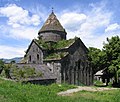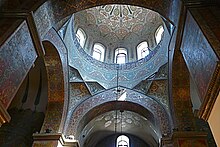
A khachkar or Armenian cross-stone is a carved, memorial stele bearing a cross, and often with additional motifs such as rosettes, interlaces, and botanical motifs. Khachkars are characteristic of medieval Christian Armenian art.
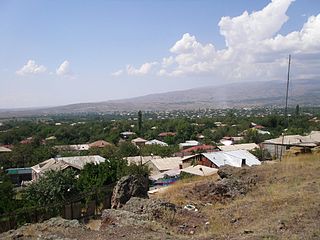
Oshakan is a village in the Ashtarak Municipality of the Aragatsotn Province of Armenia located 3 kilometers southwest from Ashtarak. It is well known to historians and pilgrims of the Armenian Apostolic Church as the site of the grave of Mesrop Mashtots, the inventor of the Armenian alphabet.
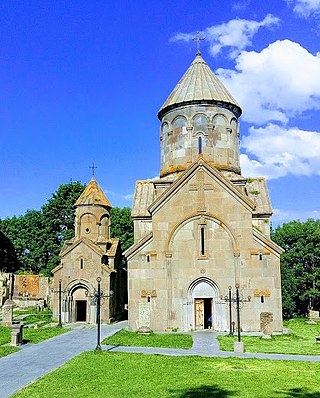
Kecharis Monastery, is a medieval Armenian monastic complex dating back to the 11th to 13th centuries, located 60 km from Yerevan, in the ski resort town of Tsaghkadzor in Armenia. Nestled in the Pambak mountains, Kecharis was founded by a Pahlavuni prince in the 11th century, and construction continued until the middle of the 13th century with its acquisition by the Proshian family. In the 12th and 13th centuries, Kecharis was a major religious center of Armenia and a place of higher education. Today, the monastery has been fully restored and is clearly visible from the ski slopes.

Haghartsin, also Hałarcin Monastery, is a 13th-century monastery located near the town of Dilijan in the Tavush Province of Armenia. It was built between the 10th and 13th centuries ; much of it under the patronage of the Bagratuni dynasty.

Haghpat Monastery, also known as Haghpatavank, is a medieval monastery complex in Haghpat, Armenia, built between the 10th and 13th century.

Akhtala, also known as Pghindzavank is a 10th-century Armenian Apostolic monastery located in the town of Akhtala in the marz of Lori, 185 kilometers (115 mi) north of Yerevan and 87 kilometers south of Tbilisi. The monastery is currently inactive. The fortress played a major role in protecting the north-western regions of Armenia (Gugark) and is among the most well preserved of all in modern Armenia. The main church at the compound is famous for its highly artistic frescoes, which cover the inside walls, the partitions, and the bearings of the building. The frescoes of Akhtala Monastery, in Armenian-Chalcedonian style, were commissionned by the Zakarid ruler Ivane I Zakarian in 1205-1216.

The Tatev Monastery is a 9th-century Armenian Apostolic Christian monastery located on a large basalt plateau near the village of Tatev in the Syunik Province in southeastern Armenia. The term "Tatev" usually refers to the monastery. The monastic ensemble stands on the edge of a deep gorge of the Vorotan River. Tatev is known as the bishopric seat of Syunik and played a significant role in the history of the region as a center of economic, political, spiritual and cultural activity.

Armenian art is the unique form of art developed over the last five millennia in which the Armenian people lived on the Armenian Highland. Armenian architecture and miniature painting have dominated Armenian art and have shown consistent development over the centuries. Other forms of Armenian art include sculpture, fresco, mosaic, ceramic, metalwork, engraving, and textiles, especially Armenian carpets.
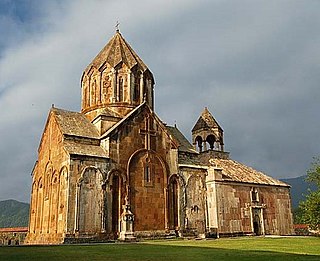
Culture of Artsakh includes artifacts of tangible and intangible culture that has been historically associated with Artsakh in the Southern Caucasus, controlled by Azerbaijan. These include monuments of religious and civil architecture, memorial and defense structures, and various forms of art.

Zoravor Surp Astvatsatsin Church is the second oldest surviving church in Yerevan. It was previously known as Surp Astvatsatsin. However, the name Zoravor was added because the church was home to the 13th century bible of Zoravor.

Sanahin Monastery is an Armenian monastery founded in the 10th century in Sanahin in the Lori Province of Armenia.
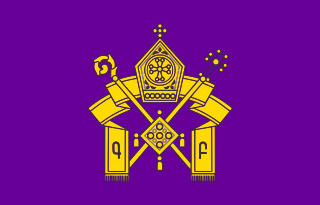
Mother See of Holy Etchmiadzin, known in Armenian as simply the Mother See, is the governing body of the Armenian Apostolic Church. It is headquartered around Etchmiadzin Cathedral in Vagharshapat (Etchmiadzin), Armenia and is the seat of the Catholicos of All Armenians, the head of the church.

Arakelots Monastery was an Armenian monastery in the historic province of Taron, 11 km south-east of Mush (Muş), in present-day eastern Turkey. According to tradition, Gregory the Illuminator founded the monastery to house relics of several apostles. The monastery was, however, most likely built in the 11th century. During the 12th-13th centuries it was a major center of learning. In the following centuries it was expanded, destroyed and renovated. It remained one of the prominent monasteries of Turkish (Western) Armenia until the Armenian genocide of 1915, when it was attacked and subsequently abandoned. It remained standing until the 1960s when it was reportedly blown up. Today, ruins of the monastery are still visible.

The Armenian eternity sign or Arevakhach is an ancient Armenian national symbol and a symbol of the national identity of the Armenian people. It is one of the most common symbols in Armenian architecture, carved on khachkars and on walls of churches.

Araratian Pontifical Diocese is the largest diocese of the Armenian Apostolic Church and one of the oldest dioceses in the world, covering the city of Yerevan and the Ararat Province within Armenia.

Saint Christopher Monastery is a restored Armenian church of the 7th century, located in a cemetery 2.2 kilometres (1.4 mi) southeast of the outskirts of Dashtadem village and Dashtadem Fortress in the Aragatsotn Province of Armenia. Adjacent to the church (north) is a 13th-century stone rectangular tower (bell/defensive/funerary) with sloped walls. It has small windows on the upper portion of the wall, but no access to the interior. The surrounding cemetery has been in use from the 6th century to modern times, and contains several interesting khachkars. A low-stone wall surrounds the complex and a section of the old cemetery. Dashtadem Fortress may be seen in the distance from the monastery.

Diocese of Vayots Dzor, is one of the newest dioceses of the Armenian Apostolic Church covering the Vayots Dzor Province of Armenia. The diocesan headquarters are located in the town of Yeghegnadzor. The seat of the bishop is the 12th-century Holy Mother of God Cathedral of Yeghegnadzor.
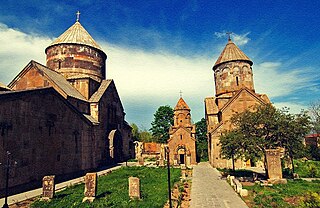
Diocese of Kotayk, is a diocese of the Armenian Apostolic Church covering the Kotayk Province of Armenia. The name is derived from the historic Kotayk canton of Ayrarat province of Armenia Major.

Diocese of Aragatsotn, is a diocese of the Armenian Apostolic Church covering the Aragatsotn Province of Armenia. The name is derived from the historic Aragatsotn canton of Ayrarat province of Kingdom of Armenia.
Armenian medieval sculptures are sculptures created in the medieval period. They are most present on or in churches, martyries, and free-standing monuments, such as four-sided stelae and khachkars (crossstones). The popularity of sculpture in the Armenian medieval art was due to midis- a three-layer layout of stones, when two rows of hewn stones were joined with lime mortar, and the surface got an artistic treatment.



































































































































